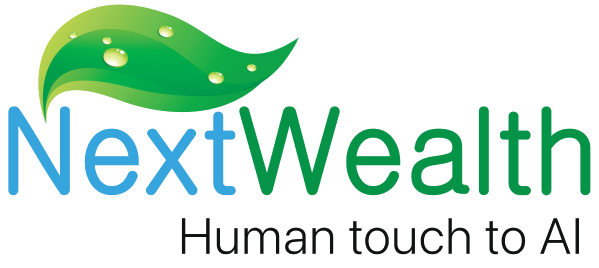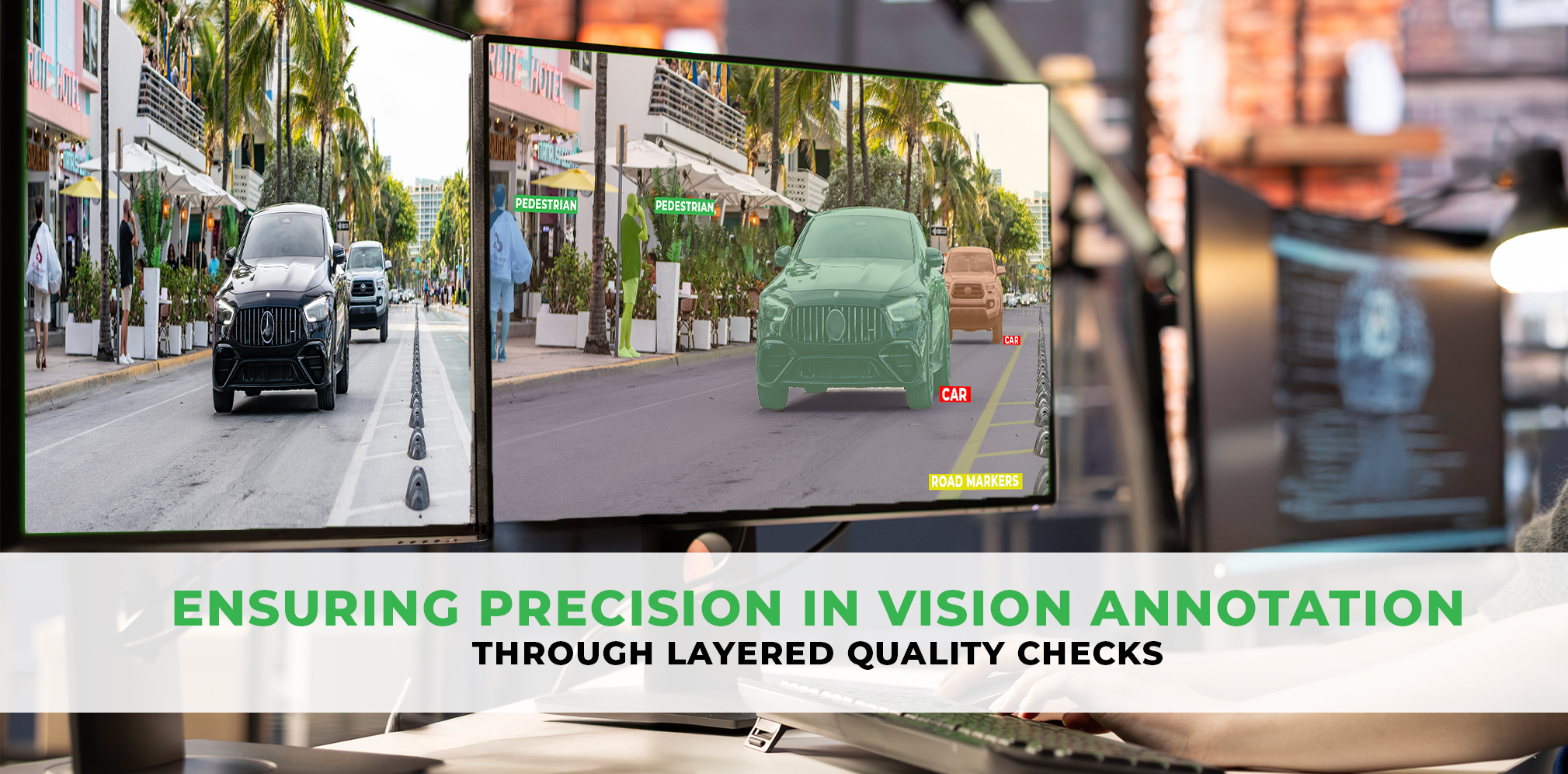Quick Overview
This blog explores the importance of multi-stage quality control (QC) in ensuring the reliability and accuracy of computer vision (CV) annotations. It explains how a structured multi-layered QC approach that incorporates peer reviews, domain expert verification, and final gold-standard audits catches errors early and enhances model performance. Key points include:
- The need for multi-stage QC to prevent error propagation across large-scale datasets.
- The role of domain-trained experts in ensuring precise, context-specific annotations.
- NextWealth’s process-driven approach for scalable, high-quality annotation workflows.
- How multi-stage QC enhances model generalization, reduces bias, and aligns with regulatory compliance requirements.
Introduction: Why Quality Control Can Make or Break Vision Models
Artificial intelligence systems don’t fail because of a lack of algorithms they fail because of flawed data. In computer vision, the cost of inaccurate annotation can be staggering. A single mislabeled frame can ripple into poor model predictions, leading to consequences as severe as a misdiagnosed medical scan, an autonomous car making the wrong maneuver, or a security system overlooking a real threat. The stakes are not just technical they are human, financial, and reputational. This is why quality control in annotation cannot be treated as an afterthought. It is not just about producing labeled data; it is about producing the right labeled data, at scale, consistently. At NextWealth, we recognize that error-free annotation is the backbone of trustworthy AI. Our focus has been on building multi-stage quality control frameworks that bring structure, accountability, and expertise into every project ensuring that the data feeding AI models is not only accurate but also reliable enough to be deployed in the real world.
The Challenges of Maintaining Annotation Accuracy at Scale
Achieving annotation accuracy in a lab environment with a small dataset is relatively straightforward. The real challenge comes when AI teams move to production-scale datasets involving millions of frames, objects, and attributes.
Some Key Challenges:Annotation Volume: Modern CV projects can require tens of millions of objects to be annotated across image and video datasets. Each frame may have multiple bounding boxes, polygons, attributes, or metadata tags, multiplying the complexity.
Annotation Complexity: Computer vision is not limited to simple 2D bounding boxes. Teams must handle semantic segmentation, instance segmentation, lane marking, temporal tracking across video frames, 3D cuboids for LiDAR data, and sensor fusion across modalities. Each task demands unique skill sets and precise execution.
Variability and Subjectivity: When hundreds of annotators are working simultaneously, differences in interpretation inevitably creep in. Edge cases for instance, whether a distant blurry object is a pedestrian, or a pole often require domain-specific expertise. Moreover, guidelines may evolve mid-project, requiring retraining and consistent adoption. Error Propagation: If an error slips past early-stage checks, it gets amplified when scaled across thousands of frames. A single misinterpreted labeling rule can cause widespread dataset contamination, impacting the entire model pipeline. Without a robust QC framework, the result is costly rework, delayed deployment timelines, and compromised AI outcomes.
Multi-Stage Quality Control in CV Annotation: Ensuring Accuracy at Scale
It is a layered process designed to catch errors at multiple checkpoints rather than relying on a single final review. Instead of one pair of eyes validating annotations, multi-stage QC distributes responsibility across peer reviews, expert audits, gold-standard.
Stage 1: Peer Review / Checker Validation – Annotators themselves perform a peer-to-peer review where a second annotator validates the work of the first. This ensures immediate error detection for straightforward cases and promotes accountability.
Stage 2: Domain Expert Verification – Domain-trained reviewers’ step in to handle ambiguous, complex, or industry-specific annotations. For example, medical annotators validate tumor segmentation, or automotive experts assess lane marking consistency. Their knowledge helps ensure contextual accuracy.
Stage 3: Final Audit Against Gold-Standard Data – A final quality assurance layer compares annotations against gold-standard datasets curated by subject matter experts (SMEs). Edge cases or unresolved issues get escalated to SMEs for arbitration. This step ensures traceability & confidence in final datasets The advantage of this structured approach is clear: errors are caught early, context-specific accuracy is assured, and datasets meet the high standards demanded by enterprise AI teams. At NextWealth, this process is not optional it is fundamental. We have invested deeply in designing and operationalizing frameworks that embed multi-stage checks into our workflows. This ensures that annotation quality is never left to chance, and every dataset delivered reflects the reliability and precision that our clients expect from mission-critical AI systems.
Why Multi-Stage QC Improves Model Outcomes
Why is this approach superior to a single-layer QA? The benefits span both model performance and business impact:
More Reliable Ground Truth: With multiple checkpoints, noise is reduced, and the resulting dataset is cleaner. Reliable ground truth translates to stronger model generalization, fewer false positives, and improved recall.
Bias Reduction: Edge cases and subjectivity are handled consistently through expert review, reducing labeling bias that could otherwise skew model predictions.
Transparency and Trust: Clients gain confidence when they see a multi-stage QC framework with measurable quality metrics like precision, recall, and F1 scores rather than opaque “final checks.”
Regulatory and Compliance Alignment: In sectors like healthcare or insurance, compliance requires strict data accuracy. Multi-stage QC provides the audit readiness and traceability regulators demand. Simply put better quality control leads to better-performing models and higher trust in AI systems.
NextWealth’s Approach to Multi-Stage Quality Assurance
At NextWealth, multi-stage QC is not an afterthought it is built into every project pipeline. Our philosophy is clear: HITL-first, AI-assisted, and domain-driven.
Here’s how we operationalize it:HITL-First Approach: While AI-assisted pre-annotation tools accelerate the process, every annotation passes through human validation at multiple stages. This ensures errors introduced by automation are caught and corrected.
Multi-Level Review Structure: Peer review for base validation, expert review for complex scenarios, and gold-standard audits with SME escalation. This structured hierarchy ensures that no annotation leaves unchecked.
Domain-Trained Teams: We maintain vertical-specific annotation teams trained in domains such as healthcare, automotive, and retail. Their contextual expertise drastically reduces subjectivity and misinterpretation.
Scalability Through Process Rigor: NextWealth has optimized SOP-driven workflows that allow scaling from a pilot dataset to millions of frames without compromising quality. Through this approach, we don’t just deliver annotations we deliver datasets that clients can trust to power mission-critical AI systems.
Conclusion: Quality Is a Process, not a Checkbox
The truth is unmistakable: the success or failure of a computer vision model is determined long before deployment. It begins with the integrity of the data it is trained on. High-quality annotation cannot be guaranteed by a one-time check; it demands a disciplined, multi-stage quality assurance process that scales with complexity and volume. At NextWealth, we don’t treat quality as an afterthought. It is engineered into every step of our operations. From peer reviews to expert validation and gold-standard audits, our frameworks ensure that every dataset meets uncompromising standards of accuracy, reliability, and auditability. For enterprises building production-grade AI, the choice is clear: partner with a provider who treats quality not as a task to complete, but as a relentless discipline one that safeguards trust, reduces risk, and fuels AI systems you can depend on.

